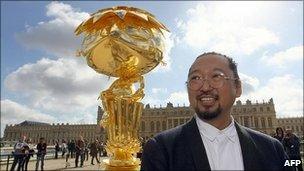Aristocrat's anger at Versailles Murakami 'manga' show
- Published

Takashi Murakami hopes his art can guide people around the wonders of Versailles
A French aristocrat descended from Louis XIV is seeking a court order to stop a Japanese artist exhibiting his work at the Palace of Versailles.
Work by Takashi Murakami, who blends Japanese classical art with manga-style modernity, is on show until December.
But Prince Sixte-Henri de Bourbon-Parme believes Murakami's brightly coloured work dishonours the memory of his ancestors.
The prince and fellow protesters say Murakami "denatures" French culture.
"By exhibiting at Versailles, artists benefit from an added value," he told the AFP news agency.
"We're not against the modernity of art but against a way of thinking that denatures and does French culture no good," the prince said.
'Elegance and sophistication'
Murakami's work sits in striking contrast to the classical French splendour of Versailles, the palace built during the reign of Louis XIV, the "Sun King".
The colourful synthetics contrast with the classical decor of the palace
The 48-year-old artist trained in traditional Japanese techniques but has risen to prominence through his "super-flat" method, incorporating two-dimensional anime and manga.
He has been dubbed "the Japanese Andy Warhol" and has been exhibited and feted across the world.
He describes his retrospective at Versailles as an opportunity to interpret the story of the Versailles through Japanese eyes, calling it "a fantastic tale coming from a very distant kingdom".
The palace is "one of the greatest symbols of Western history", the artist said.
"It is the emblem of an ambition for elegance, sophistication and art that most of us can only dream of."
Murakami's striking works include a golden buddha in the palace courtyard, and a towering fibreglass and iron sculpture, adorned with religious iconography incorporating ancient Mayan culture and symbols of Tibetan Buddhism, in the Hercules Salon.
Cartoon art controversy at Palace of Versailles
Completed in 1736, the Hercules Salon is named for the ceiling painting of the Apotheosis of Hercules, by Francois Le Moyne, which dominates the room. Originally part of a chapel and latterly a ball room and a room for diplomatic events, the salon is decorated by two large works by the Italian Renaissance painter Veronese.
Murakami's 7m (23ft)-high work is called Mister Pointy.
While the artist professes genuine admiration for the traditions and culture of Versailles, those taking the legal route say they feel compelled to speak up on behalf of opponents of the show.
"It's about translating into judicial terms the debate and opposition that have been raised by exposing Murakami works," Arnaud Upinsky, president of the Versailles Defence Coordination, told AFP.
The Bourbon-Parme dynasty fought once before against an art exhibition at Versailles.
In 2008 Prince Sixte-Henri's nephew, Prince Charles-Emmanuel de Bourbon-Parme, sought to ban a show by US sculptor Jeff Koons, but failed in the courts.